Statistical Analysis of Experiments: PSYCH STAT 3200 Assignment
VerifiedAdded on 2022/09/10
|8
|1643
|26
Homework Assignment
AI Summary
This document presents solutions to a psychology statistics assignment, analyzing two distinct experimental scenarios. The first part investigates a coin flip prediction experiment, requiring the student to formulate hypotheses, determine statistical significance, calculate effect size (Cohen's d), and report results in APA format. The analysis involves a one-sample t-test. The second part focuses on an experiment comparing different treatment modalities for depression (psychotropic medication, psychotherapy, and a control group). This involves stating hypotheses, testing for equal variances using Levene's test, determining if there is a significant difference in depression levels between the groups using ANOVA, calculating effect size, and summarizing the results of Tukey's post hoc procedure. The document demonstrates understanding of statistical concepts and the ability to interpret and present findings according to APA guidelines.
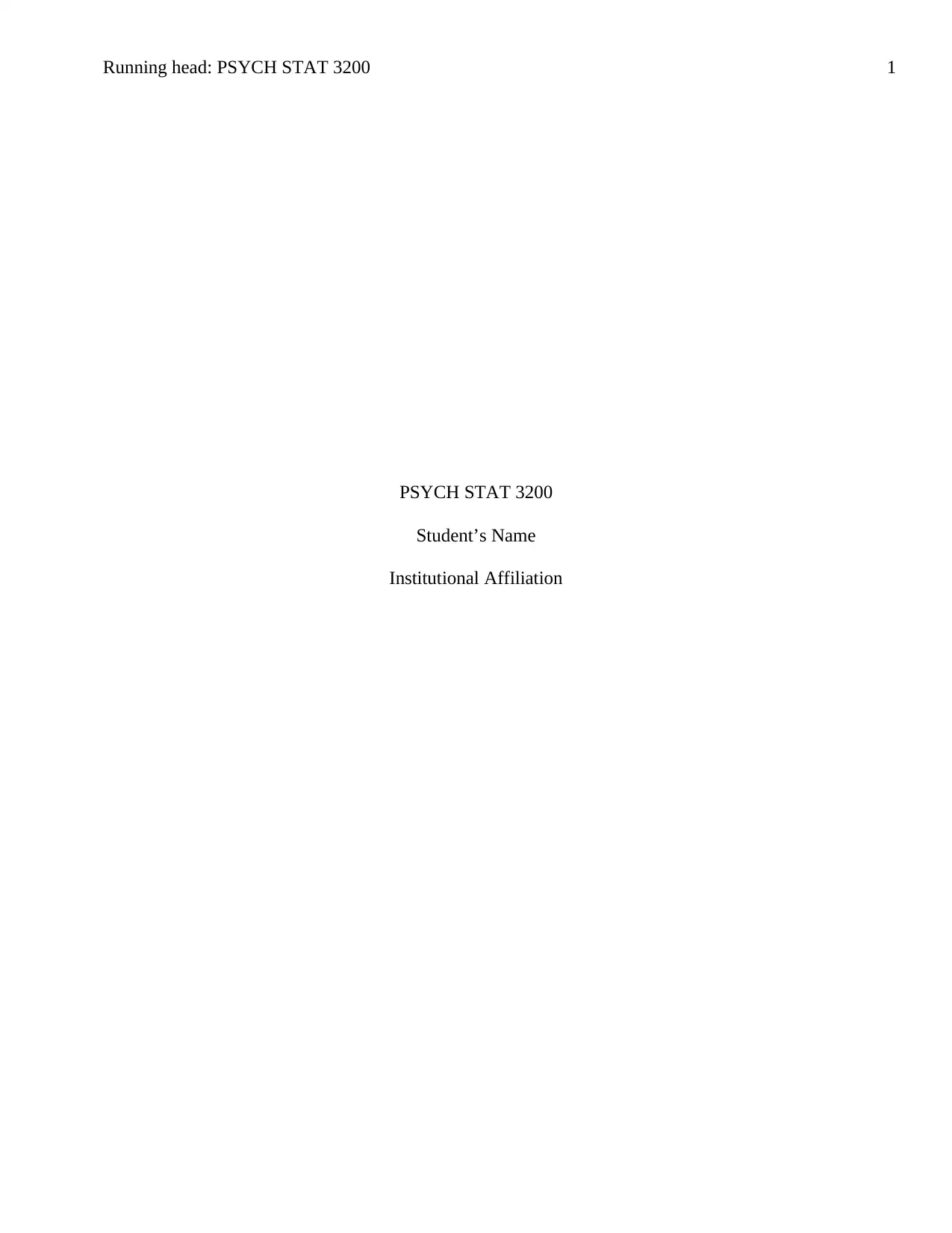
Running head: PSYCH STAT 3200 1
PSYCH STAT 3200
Student’s Name
Institutional Affiliation
PSYCH STAT 3200
Student’s Name
Institutional Affiliation
Paraphrase This Document
Need a fresh take? Get an instant paraphrase of this document with our AI Paraphraser
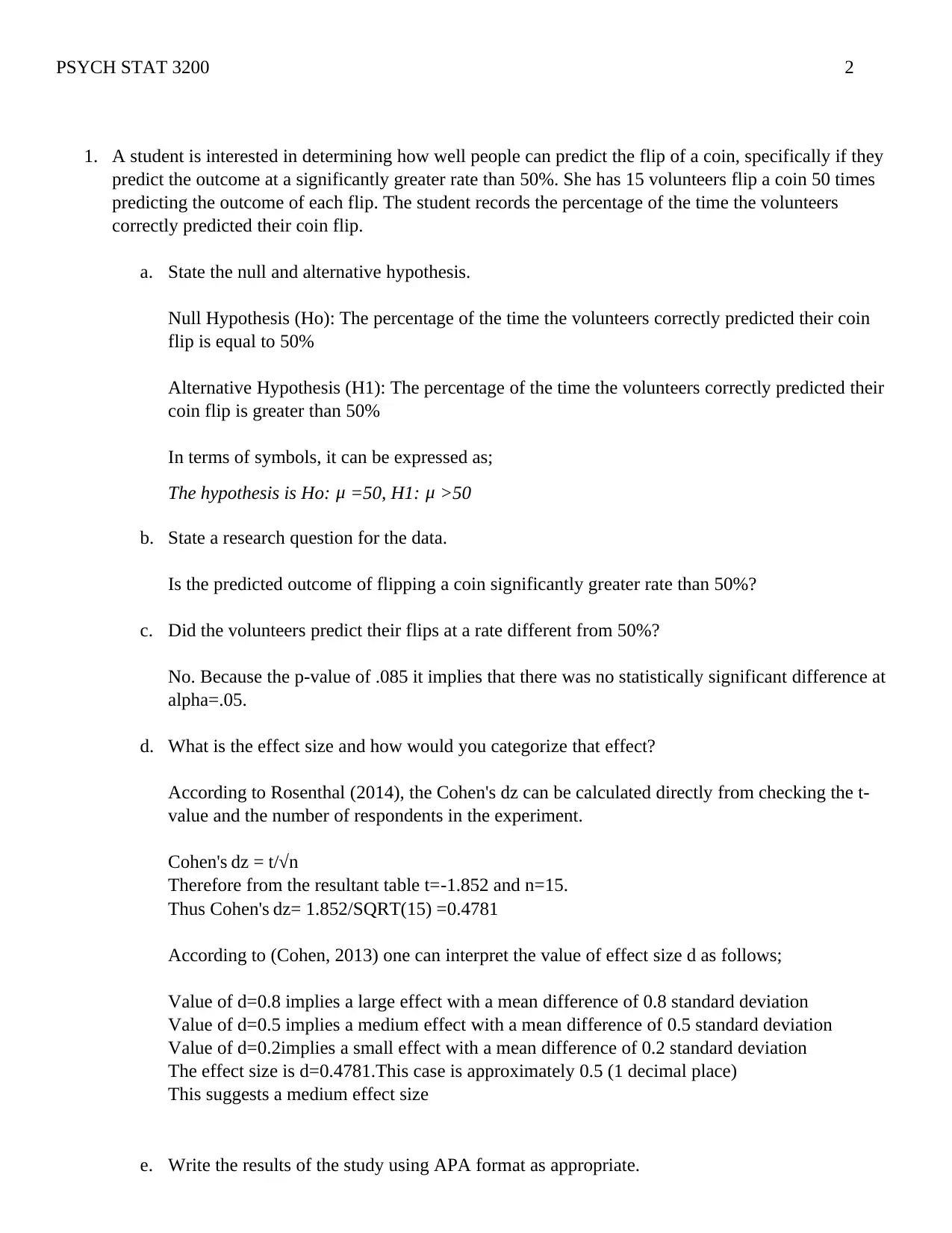
PSYCH STAT 3200 2
1. A student is interested in determining how well people can predict the flip of a coin, specifically if they
predict the outcome at a significantly greater rate than 50%. She has 15 volunteers flip a coin 50 times
predicting the outcome of each flip. The student records the percentage of the time the volunteers
correctly predicted their coin flip.
a. State the null and alternative hypothesis.
Null Hypothesis (Ho): The percentage of the time the volunteers correctly predicted their coin
flip is equal to 50%
Alternative Hypothesis (H1): The percentage of the time the volunteers correctly predicted their
coin flip is greater than 50%
In terms of symbols, it can be expressed as;
The hypothesis is Ho: μ =50, H1: μ >50
b. State a research question for the data.
Is the predicted outcome of flipping a coin significantly greater rate than 50%?
c. Did the volunteers predict their flips at a rate different from 50%?
No. Because the p-value of .085 it implies that there was no statistically significant difference at
alpha=.05.
d. What is the effect size and how would you categorize that effect?
According to Rosenthal (2014), the Cohen's dz can be calculated directly from checking the t-
value and the number of respondents in the experiment.
Cohen's dz = t/√n
Therefore from the resultant table t=-1.852 and n=15.
Thus Cohen's dz= 1.852/SQRT(15) =0.4781
According to (Cohen, 2013) one can interpret the value of effect size d as follows;
Value of d=0.8 implies a large effect with a mean difference of 0.8 standard deviation
Value of d=0.5 implies a medium effect with a mean difference of 0.5 standard deviation
Value of d=0.2implies a small effect with a mean difference of 0.2 standard deviation
The effect size is d=0.4781.This case is approximately 0.5 (1 decimal place)
This suggests a medium effect size
e. Write the results of the study using APA format as appropriate.
1. A student is interested in determining how well people can predict the flip of a coin, specifically if they
predict the outcome at a significantly greater rate than 50%. She has 15 volunteers flip a coin 50 times
predicting the outcome of each flip. The student records the percentage of the time the volunteers
correctly predicted their coin flip.
a. State the null and alternative hypothesis.
Null Hypothesis (Ho): The percentage of the time the volunteers correctly predicted their coin
flip is equal to 50%
Alternative Hypothesis (H1): The percentage of the time the volunteers correctly predicted their
coin flip is greater than 50%
In terms of symbols, it can be expressed as;
The hypothesis is Ho: μ =50, H1: μ >50
b. State a research question for the data.
Is the predicted outcome of flipping a coin significantly greater rate than 50%?
c. Did the volunteers predict their flips at a rate different from 50%?
No. Because the p-value of .085 it implies that there was no statistically significant difference at
alpha=.05.
d. What is the effect size and how would you categorize that effect?
According to Rosenthal (2014), the Cohen's dz can be calculated directly from checking the t-
value and the number of respondents in the experiment.
Cohen's dz = t/√n
Therefore from the resultant table t=-1.852 and n=15.
Thus Cohen's dz= 1.852/SQRT(15) =0.4781
According to (Cohen, 2013) one can interpret the value of effect size d as follows;
Value of d=0.8 implies a large effect with a mean difference of 0.8 standard deviation
Value of d=0.5 implies a medium effect with a mean difference of 0.5 standard deviation
Value of d=0.2implies a small effect with a mean difference of 0.2 standard deviation
The effect size is d=0.4781.This case is approximately 0.5 (1 decimal place)
This suggests a medium effect size
e. Write the results of the study using APA format as appropriate.
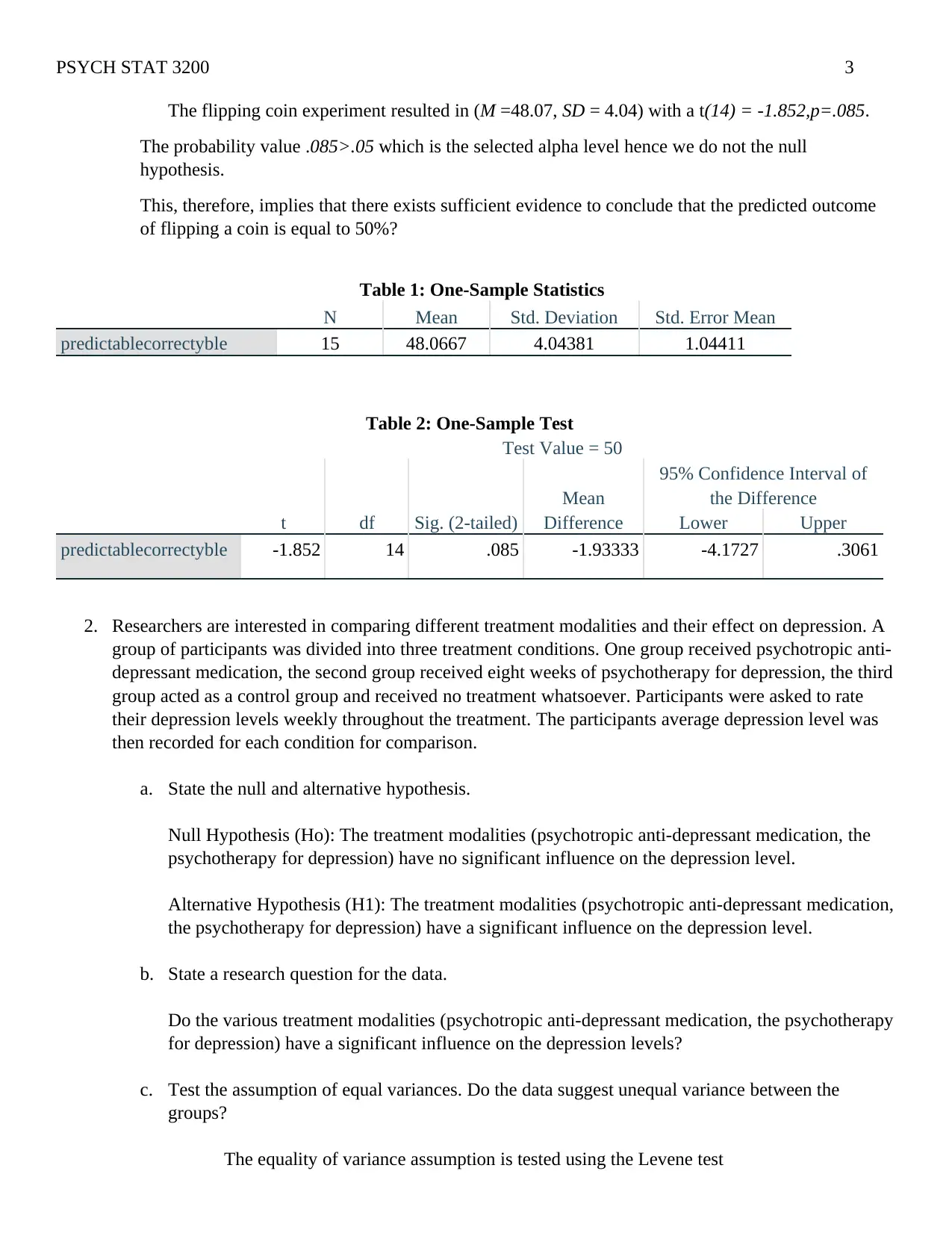
PSYCH STAT 3200 3
The flipping coin experiment resulted in (M =48.07, SD = 4.04) with a t(14) = -1.852,p=.085.
The probability value .085>.05 which is the selected alpha level hence we do not the null
hypothesis.
This, therefore, implies that there exists sufficient evidence to conclude that the predicted outcome
of flipping a coin is equal to 50%?
Table 1: One-Sample Statistics
N Mean Std. Deviation Std. Error Mean
predictablecorrectyble 15 48.0667 4.04381 1.04411
Table 2: One-Sample Test
Test Value = 50
t df Sig. (2-tailed)
Mean
Difference
95% Confidence Interval of
the Difference
Lower Upper
predictablecorrectyble -1.852 14 .085 -1.93333 -4.1727 .3061
2. Researchers are interested in comparing different treatment modalities and their effect on depression. A
group of participants was divided into three treatment conditions. One group received psychotropic anti-
depressant medication, the second group received eight weeks of psychotherapy for depression, the third
group acted as a control group and received no treatment whatsoever. Participants were asked to rate
their depression levels weekly throughout the treatment. The participants average depression level was
then recorded for each condition for comparison.
a. State the null and alternative hypothesis.
Null Hypothesis (Ho): The treatment modalities (psychotropic anti-depressant medication, the
psychotherapy for depression) have no significant influence on the depression level.
Alternative Hypothesis (H1): The treatment modalities (psychotropic anti-depressant medication,
the psychotherapy for depression) have a significant influence on the depression level.
b. State a research question for the data.
Do the various treatment modalities (psychotropic anti-depressant medication, the psychotherapy
for depression) have a significant influence on the depression levels?
c. Test the assumption of equal variances. Do the data suggest unequal variance between the
groups?
The equality of variance assumption is tested using the Levene test
The flipping coin experiment resulted in (M =48.07, SD = 4.04) with a t(14) = -1.852,p=.085.
The probability value .085>.05 which is the selected alpha level hence we do not the null
hypothesis.
This, therefore, implies that there exists sufficient evidence to conclude that the predicted outcome
of flipping a coin is equal to 50%?
Table 1: One-Sample Statistics
N Mean Std. Deviation Std. Error Mean
predictablecorrectyble 15 48.0667 4.04381 1.04411
Table 2: One-Sample Test
Test Value = 50
t df Sig. (2-tailed)
Mean
Difference
95% Confidence Interval of
the Difference
Lower Upper
predictablecorrectyble -1.852 14 .085 -1.93333 -4.1727 .3061
2. Researchers are interested in comparing different treatment modalities and their effect on depression. A
group of participants was divided into three treatment conditions. One group received psychotropic anti-
depressant medication, the second group received eight weeks of psychotherapy for depression, the third
group acted as a control group and received no treatment whatsoever. Participants were asked to rate
their depression levels weekly throughout the treatment. The participants average depression level was
then recorded for each condition for comparison.
a. State the null and alternative hypothesis.
Null Hypothesis (Ho): The treatment modalities (psychotropic anti-depressant medication, the
psychotherapy for depression) have no significant influence on the depression level.
Alternative Hypothesis (H1): The treatment modalities (psychotropic anti-depressant medication,
the psychotherapy for depression) have a significant influence on the depression level.
b. State a research question for the data.
Do the various treatment modalities (psychotropic anti-depressant medication, the psychotherapy
for depression) have a significant influence on the depression levels?
c. Test the assumption of equal variances. Do the data suggest unequal variance between the
groups?
The equality of variance assumption is tested using the Levene test
⊘ This is a preview!⊘
Do you want full access?
Subscribe today to unlock all pages.

Trusted by 1+ million students worldwide
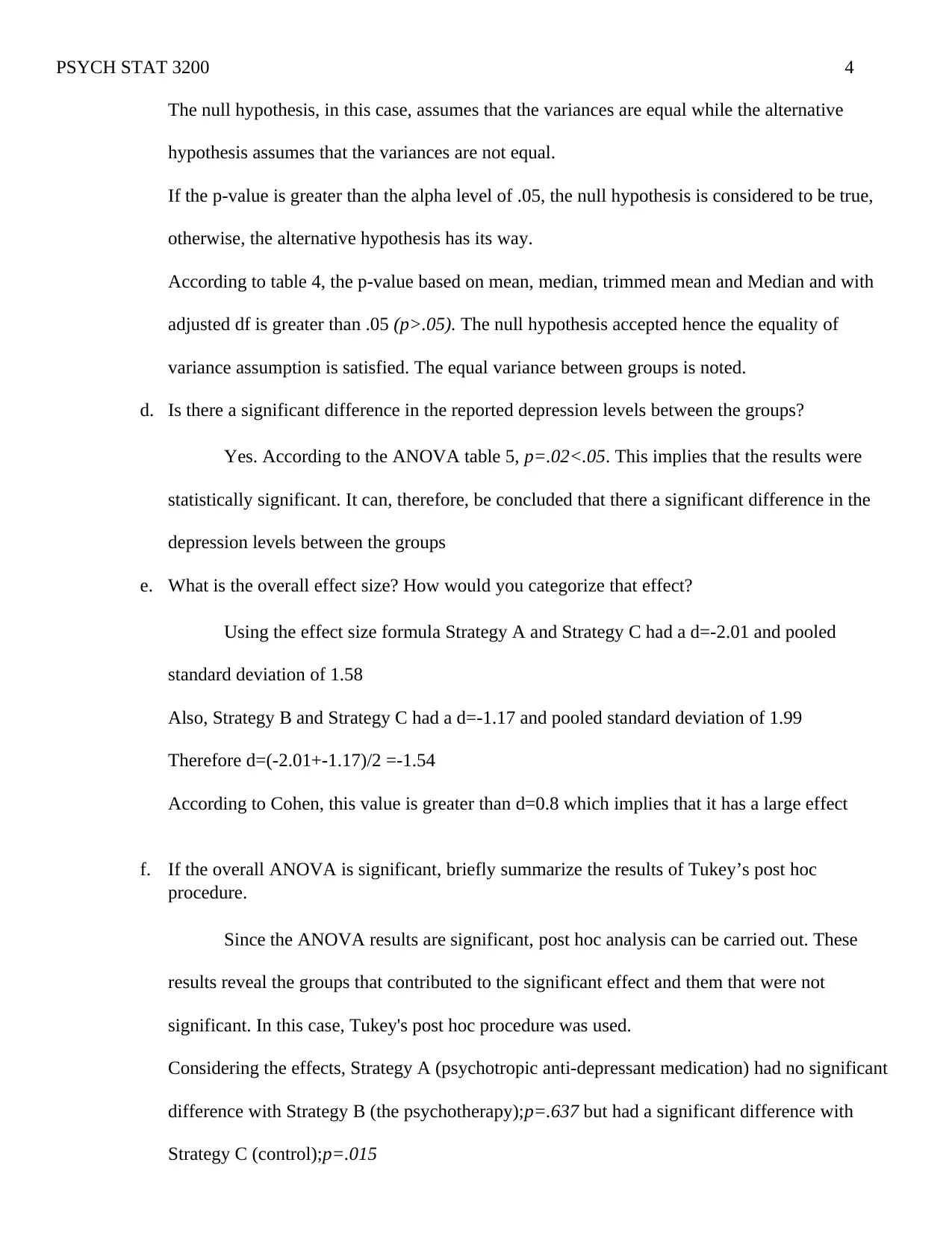
PSYCH STAT 3200 4
The null hypothesis, in this case, assumes that the variances are equal while the alternative
hypothesis assumes that the variances are not equal.
If the p-value is greater than the alpha level of .05, the null hypothesis is considered to be true,
otherwise, the alternative hypothesis has its way.
According to table 4, the p-value based on mean, median, trimmed mean and Median and with
adjusted df is greater than .05 (p>.05). The null hypothesis accepted hence the equality of
variance assumption is satisfied. The equal variance between groups is noted.
d. Is there a significant difference in the reported depression levels between the groups?
Yes. According to the ANOVA table 5, p=.02<.05. This implies that the results were
statistically significant. It can, therefore, be concluded that there a significant difference in the
depression levels between the groups
e. What is the overall effect size? How would you categorize that effect?
Using the effect size formula Strategy A and Strategy C had a d=-2.01 and pooled
standard deviation of 1.58
Also, Strategy B and Strategy C had a d=-1.17 and pooled standard deviation of 1.99
Therefore d=(-2.01+-1.17)/2 =-1.54
According to Cohen, this value is greater than d=0.8 which implies that it has a large effect
f. If the overall ANOVA is significant, briefly summarize the results of Tukey’s post hoc
procedure.
Since the ANOVA results are significant, post hoc analysis can be carried out. These
results reveal the groups that contributed to the significant effect and them that were not
significant. In this case, Tukey's post hoc procedure was used.
Considering the effects, Strategy A (psychotropic anti-depressant medication) had no significant
difference with Strategy B (the psychotherapy);p=.637 but had a significant difference with
Strategy C (control);p=.015
The null hypothesis, in this case, assumes that the variances are equal while the alternative
hypothesis assumes that the variances are not equal.
If the p-value is greater than the alpha level of .05, the null hypothesis is considered to be true,
otherwise, the alternative hypothesis has its way.
According to table 4, the p-value based on mean, median, trimmed mean and Median and with
adjusted df is greater than .05 (p>.05). The null hypothesis accepted hence the equality of
variance assumption is satisfied. The equal variance between groups is noted.
d. Is there a significant difference in the reported depression levels between the groups?
Yes. According to the ANOVA table 5, p=.02<.05. This implies that the results were
statistically significant. It can, therefore, be concluded that there a significant difference in the
depression levels between the groups
e. What is the overall effect size? How would you categorize that effect?
Using the effect size formula Strategy A and Strategy C had a d=-2.01 and pooled
standard deviation of 1.58
Also, Strategy B and Strategy C had a d=-1.17 and pooled standard deviation of 1.99
Therefore d=(-2.01+-1.17)/2 =-1.54
According to Cohen, this value is greater than d=0.8 which implies that it has a large effect
f. If the overall ANOVA is significant, briefly summarize the results of Tukey’s post hoc
procedure.
Since the ANOVA results are significant, post hoc analysis can be carried out. These
results reveal the groups that contributed to the significant effect and them that were not
significant. In this case, Tukey's post hoc procedure was used.
Considering the effects, Strategy A (psychotropic anti-depressant medication) had no significant
difference with Strategy B (the psychotherapy);p=.637 but had a significant difference with
Strategy C (control);p=.015
Paraphrase This Document
Need a fresh take? Get an instant paraphrase of this document with our AI Paraphraser

PSYCH STAT 3200 5
Strategy B (the psychotherapy) had no significant difference with Strategy A
(psychotropic anti-depressant medication) and Strategy C (control);p>0.05
The Strategy C (control) had a significant difference with Strategy A (psychotropic anti-
depressant medication) ;p<.05 but not significantly different from Strategy B (the
psychotherapy) ;p>.05
g. Write the results of the study using APA format as appropriate.
The treatment modalities (psychotropic anti-depressant medication, the psychotherapy for
depression) were found to have a significant influence on the depression level
F(2,18)=4.934,p=.02. Here the null hypothesis is rejected at alpha=.05.
Checking the individual group effects, Strategy C (control) was found to be significantly
different from Strategy A (psychotropic anti-depressant medication);p<.05 but not significantly
different from Strategy B (the psychotherapy) ;p>.05.
Therefore Strategy A (psychotropic anti-depressant medication) had the greatest
significant influence on the depression levels.
NEW FILE.
DATASET NAME DataSet1 WINDOW=FRONT.
DATASET ACTIVATE DataSet0.
NEW FILE.
DATASET NAME DataSet2 WINDOW=FRONT.
DATASET ACTIVATE DataSet0.
DATASET CLOSE DataSet2.
DATASET ACTIVATE DataSet1.
DATASET CLOSE DataSet0.
ONEWAY wordrecall BY stratergy
/STATISTICS DESCRIPTIVES HOMOGENEITY
/MISSING ANALYSIS
/POSTHOC=TUKEY ALPHA(0.05).
Table 3:Descriptives
Strategy B (the psychotherapy) had no significant difference with Strategy A
(psychotropic anti-depressant medication) and Strategy C (control);p>0.05
The Strategy C (control) had a significant difference with Strategy A (psychotropic anti-
depressant medication) ;p<.05 but not significantly different from Strategy B (the
psychotherapy) ;p>.05
g. Write the results of the study using APA format as appropriate.
The treatment modalities (psychotropic anti-depressant medication, the psychotherapy for
depression) were found to have a significant influence on the depression level
F(2,18)=4.934,p=.02. Here the null hypothesis is rejected at alpha=.05.
Checking the individual group effects, Strategy C (control) was found to be significantly
different from Strategy A (psychotropic anti-depressant medication);p<.05 but not significantly
different from Strategy B (the psychotherapy) ;p>.05.
Therefore Strategy A (psychotropic anti-depressant medication) had the greatest
significant influence on the depression levels.
NEW FILE.
DATASET NAME DataSet1 WINDOW=FRONT.
DATASET ACTIVATE DataSet0.
NEW FILE.
DATASET NAME DataSet2 WINDOW=FRONT.
DATASET ACTIVATE DataSet0.
DATASET CLOSE DataSet2.
DATASET ACTIVATE DataSet1.
DATASET CLOSE DataSet0.
ONEWAY wordrecall BY stratergy
/STATISTICS DESCRIPTIVES HOMOGENEITY
/MISSING ANALYSIS
/POSTHOC=TUKEY ALPHA(0.05).
Table 3:Descriptives
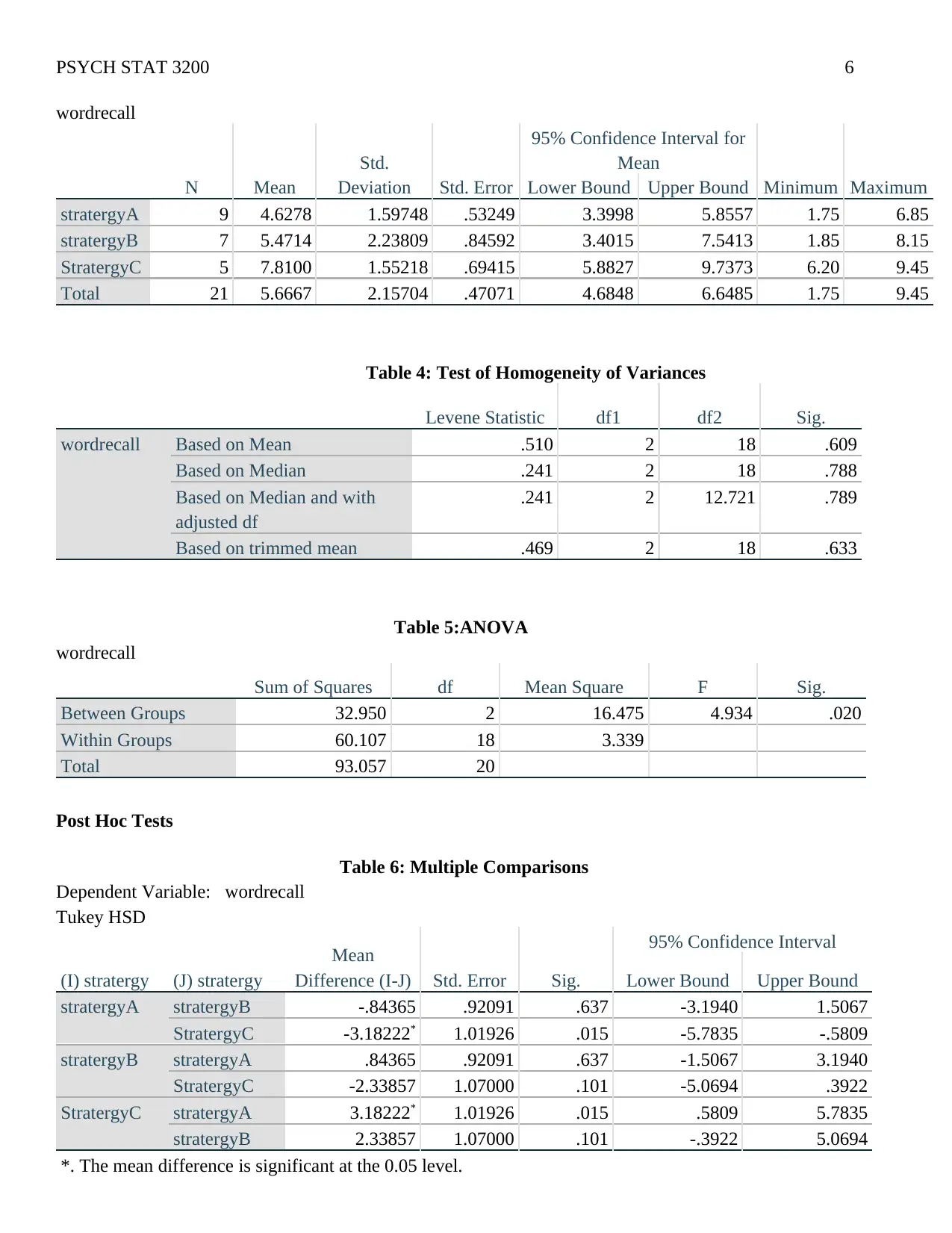
PSYCH STAT 3200 6
wordrecall
N Mean
Std.
Deviation Std. Error
95% Confidence Interval for
Mean
Minimum MaximumLower Bound Upper Bound
stratergyA 9 4.6278 1.59748 .53249 3.3998 5.8557 1.75 6.85
stratergyB 7 5.4714 2.23809 .84592 3.4015 7.5413 1.85 8.15
StratergyC 5 7.8100 1.55218 .69415 5.8827 9.7373 6.20 9.45
Total 21 5.6667 2.15704 .47071 4.6848 6.6485 1.75 9.45
Table 4: Test of Homogeneity of Variances
Levene Statistic df1 df2 Sig.
wordrecall Based on Mean .510 2 18 .609
Based on Median .241 2 18 .788
Based on Median and with
adjusted df
.241 2 12.721 .789
Based on trimmed mean .469 2 18 .633
Table 5:ANOVA
wordrecall
Sum of Squares df Mean Square F Sig.
Between Groups 32.950 2 16.475 4.934 .020
Within Groups 60.107 18 3.339
Total 93.057 20
Post Hoc Tests
Table 6: Multiple Comparisons
Dependent Variable: wordrecall
Tukey HSD
(I) stratergy (J) stratergy
Mean
Difference (I-J) Std. Error Sig.
95% Confidence Interval
Lower Bound Upper Bound
stratergyA stratergyB -.84365 .92091 .637 -3.1940 1.5067
StratergyC -3.18222* 1.01926 .015 -5.7835 -.5809
stratergyB stratergyA .84365 .92091 .637 -1.5067 3.1940
StratergyC -2.33857 1.07000 .101 -5.0694 .3922
StratergyC stratergyA 3.18222* 1.01926 .015 .5809 5.7835
stratergyB 2.33857 1.07000 .101 -.3922 5.0694
*. The mean difference is significant at the 0.05 level.
wordrecall
N Mean
Std.
Deviation Std. Error
95% Confidence Interval for
Mean
Minimum MaximumLower Bound Upper Bound
stratergyA 9 4.6278 1.59748 .53249 3.3998 5.8557 1.75 6.85
stratergyB 7 5.4714 2.23809 .84592 3.4015 7.5413 1.85 8.15
StratergyC 5 7.8100 1.55218 .69415 5.8827 9.7373 6.20 9.45
Total 21 5.6667 2.15704 .47071 4.6848 6.6485 1.75 9.45
Table 4: Test of Homogeneity of Variances
Levene Statistic df1 df2 Sig.
wordrecall Based on Mean .510 2 18 .609
Based on Median .241 2 18 .788
Based on Median and with
adjusted df
.241 2 12.721 .789
Based on trimmed mean .469 2 18 .633
Table 5:ANOVA
wordrecall
Sum of Squares df Mean Square F Sig.
Between Groups 32.950 2 16.475 4.934 .020
Within Groups 60.107 18 3.339
Total 93.057 20
Post Hoc Tests
Table 6: Multiple Comparisons
Dependent Variable: wordrecall
Tukey HSD
(I) stratergy (J) stratergy
Mean
Difference (I-J) Std. Error Sig.
95% Confidence Interval
Lower Bound Upper Bound
stratergyA stratergyB -.84365 .92091 .637 -3.1940 1.5067
StratergyC -3.18222* 1.01926 .015 -5.7835 -.5809
stratergyB stratergyA .84365 .92091 .637 -1.5067 3.1940
StratergyC -2.33857 1.07000 .101 -5.0694 .3922
StratergyC stratergyA 3.18222* 1.01926 .015 .5809 5.7835
stratergyB 2.33857 1.07000 .101 -.3922 5.0694
*. The mean difference is significant at the 0.05 level.
⊘ This is a preview!⊘
Do you want full access?
Subscribe today to unlock all pages.

Trusted by 1+ million students worldwide

PSYCH STAT 3200 7
Table 7:Homogeneous Subsets
wordrecall
Tukey HSDa,b
stratergy N
Subset for alpha = 0.05
1 2
stratergyA 9 4.6278
stratergyB 7 5.4714 5.4714
StratergyC 5 7.8100
Sig. .684 .078
Means for groups in homogeneous subsets are displayed.
a. Uses Harmonic Mean Sample Size = 6.608.
b. The group sizes are unequal. The harmonic mean of the group sizes is used. Type I error levels
are not guaranteed.
Table 7:Homogeneous Subsets
wordrecall
Tukey HSDa,b
stratergy N
Subset for alpha = 0.05
1 2
stratergyA 9 4.6278
stratergyB 7 5.4714 5.4714
StratergyC 5 7.8100
Sig. .684 .078
Means for groups in homogeneous subsets are displayed.
a. Uses Harmonic Mean Sample Size = 6.608.
b. The group sizes are unequal. The harmonic mean of the group sizes is used. Type I error levels
are not guaranteed.
Paraphrase This Document
Need a fresh take? Get an instant paraphrase of this document with our AI Paraphraser

PSYCH STAT 3200 8
Reference
Muller, K. and Cohen, J. (2013). Statistical Power Analysis for the Behavioral Sciences. Technometrics, 31(4),
p.499.
Rosenthal, R., Cooper, H., & Hedges, L. (2014). Parametric measures of effect size. The handbook of research
synthesis, 621, 231-244.
Reference
Muller, K. and Cohen, J. (2013). Statistical Power Analysis for the Behavioral Sciences. Technometrics, 31(4),
p.499.
Rosenthal, R., Cooper, H., & Hedges, L. (2014). Parametric measures of effect size. The handbook of research
synthesis, 621, 231-244.
1 out of 8
Your All-in-One AI-Powered Toolkit for Academic Success.
+13062052269
info@desklib.com
Available 24*7 on WhatsApp / Email
![[object Object]](/_next/static/media/star-bottom.7253800d.svg)
Unlock your academic potential
Copyright © 2020–2025 A2Z Services. All Rights Reserved. Developed and managed by ZUCOL.

